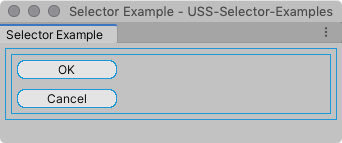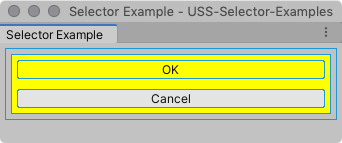简单选择器
USS 支持以下简单选择器:
- C# 类型选择器匹配特定 C# 类型的元素
- USS 类选择器匹配具有指定 USS 类的元素
-
名称选择器匹配具有指定
name属性的元素。 - 通用选择器匹配任何元素
You can combine simple selectors into complex selectors, and/or append pseudo-classes to them to target elements in specific states.
本页面描述了每种类型的简单选择器并提供了语法和示例。它使用以下 UXML 文档来演示简单选择器如何匹配元素。
<UXML xmlns="UnityEngine.UIElements">
<VisualElement name="container1">
<VisualElement name="container2" class="yellow">
<Button name="OK" class="yellow" text="OK" />
<Button name="Cancel"class="" text="Cancel" />
</VisualElement>
</VisualElement>
</UXML>
在未应用任何样式的情况下,UXML 文档生成如下所示的 UI。
| 注意: |
|---|
| Example images include margins and thin blue borders to help clearly identify individual elements for the purposes of demonstration. |

C# 类型选择器
C# 类型选择器根据它们的 C# 类型匹配元素。
| 注意: |
|---|
USS 类型选择器类似于匹配 HTML 标签的 CSS 类型选择器。例如,USS 中的 Button {...} 匹配 C# Button 类型的任何元素,相当于 CSS 中的 p {...} 匹配任何 (<p>) 段落标签。 |
语法:
C# 类型选择器是 C# 类型名称,按原样书写。
TypeName { ...}
When you write C# Type selectors, specify only the concrete object type. Do not include the namespace in the type name.
例如,这个选择器是有效的:
Button { ...}
这个选择器是无效:
UnityEngine.UIElements.Button { ...}
示例:
对于上面的示例 UXML 文档,以下样式规则匹配两个 Button 元素。
Button {
border-radius: 8px;
width: 100px;
}

名称选择器
名称选择器根据指定的 name 属性的值匹配元素。
- 在 C# 中,使用
VisualElement.name设置元素的名称。 - 在 UXML 中,可以为元素指定一个名称属性
<VisualElement name="my-nameName">
Unity 不强制任何名称约定,但您应该使面板内的元素名称唯一。使用非唯一名称可能会导致意外匹配。
| 注意: |
|---|
USS 名称选择器类似于匹配具有特定 id 属性的元素的 CSS ID 选择器。 |
语法:
名称选择器由元素的指定名称和数值符号 (#) 前缀组成。
# name { ...}
| 注意: |
|---|
| Only use the number sign # when you write the selector in a USS file. Do not use it when you assign the name to an element in a UXML or C# file. An element name that includes the number sign is invalid. For example <Button name="OK" /> is valid. <Button name="#OK" /> is not. |
示例:
对于上面的示例 UXML 文档,以下样式规则匹配第二个 Button 元素。
# Cancel {
border-width: 2px;
border-color: DarkRed;
background-color: pink;
}

USS 类选择器
类选择器匹配指定了特定 USS 类的元素。
| 注意: |
|---|
| 类选择器在 USS 中的工作方式与在 CSS 中的工作方式相同。 |
语法:
类选择器由类名和句点 (.) 前缀组成。类名不能以数字开头。
.class { ...}
| 注意: |
|---|
仅当您在 USS 文件中编写选择器时使用句点 (.) 。为 UXML 或 C# 文件中的元素指定类时不要包含它。 |
例如,使用 <Button class="yellow" /> 而不是 <Button class=".yellow" />。还要避免在类名中使用句点。Unity 的 USS 解析器将句点解释为新类的开始。 例如,如果您创建一个名为 yellow.button 的类,并创建以下 USS 规则:.yellow.button{...} 解析器将选择器解释为多个选择器,并尝试查找同时匹配 .yellow 类和 .button 类的元素。 |
当一个元素指定了多个类时,选择器只需要匹配其中一个类来匹配元素。
On the other hand, you can specify multiple classes in a selector, in which case an element must have all of those classes assigned in order to match. See Multiple selectors for details.
示例:
对于上面的示例 UXML 文档,下面的样式规则匹配名为 container2 的元素和名为 OK 的按钮元素,并将其背景颜色更改为黄色。
.yellow {
background-color: yellow;
}

通用选择器
通用选择器(有时称为通配符选择器)匹配任何元素。
语法:
* { ...}
示例:
对于上面的示例 UXML 文档,下面的样式规则匹配每个元素,并将其背景颜色更改为黄色。这包括窗口的主要区域,因为该样式表应用于窗口的根元素。
* {
background-color: yellow;
}

| 注意: |
|---|
| Because it tests every element, the universal selector can impact performance. Use it sparingly. Avoid using the universal selector with the descendant selector. When you use that combination, the system might have to test a large number of elements repeatedly, which can impact performance. |
在复杂选择器中使用通用选择器
您可以将通用选择器包含在复杂的选择器中。例如,以下 USS 规则在子选择器中使用了通用选择器,匹配 USS 类为 yellow 的元素的任何子元素下的任何按钮子元素:
.yellow > * > Button{..}